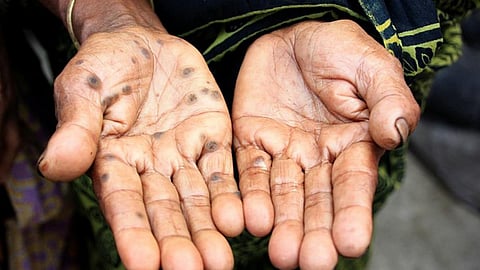
- Topics
- Feature
- Opportunities & Events
- Data
- Hindi Portal
- Topics
- Feature
- Opportunities & Events
- Data
- Hindi Portal

Extensive evidence of elevated arsenic in the food chain, mainly rice, wheat and vegetables exists. Nevertheless, the importance of exposure from food towards total arsenic exposure and associated health risks in areas with naturally occurring arsenic in drinking water is still often neglected, and accordingly, mitigations are largely focused on drinking water only.
A paper ‘Arsenic exposure from food exceeds that from drinking water in endemic area of Bihar, India’ by Mondal et al deals with how food contributes equally as drinking water towards total arsenic exposure in Bihar. In this study, the contribution of food over drinking water to overall arsenic exposure was estimated for arsenic exposed populations in Bihar, India.
The study suggests how with an increase in arsenic concentrations in drinking water arsenic exposure from food increased.
Arsenic in drinking water and food in Bihar
The severity of arsenic contamination in Bihar is well acknowledged. Out of 38 districts, 22 are reported to have arsenic in drinking water above the WHO provisional guide value of 10 μg/L. More than 9 million people are estimated to be drinking water with arsenic above 10 μg/L and 33% of the tested hand tube wells samples (n = 19,961), normally used for drinking water had arsenic above the WHO provisional guide value.
In a previous study by Nickson et al. (2007) covering 11 districts of Bihar, 29% (n = 66,623) of drinking water samples, were reported to have an arsenic concentration higher than 10 μg/L. Many of these studies focussed either exclusively or to a large extent on areas of Bihar close to the Ganga River.
In a recent study, systematically covering all 38 districts of Bihar, just 16% of the samples (n = 273), were found to have arsenic above the concentration of 10 μg/L (Richards et al., 2020).
Consumption of arsenic-contaminated food can be a relatively important route of exposure. However, estimates of overall arsenic exposure from food in Bihar exposed populations is sparse: only three studies to date in international journals have reported arsenic concentrations in food items from rural Bihar.
These studies are either focussed on a particular aspect of exposure or localised and limited by small sample sizes.
The study
To more fully understand the arsenic exposure from food in arsenic exposed populations of Bihar, India, in this study, we conducted a detailed dietary assessment of adult participants, male and female from each household using 24-h recall and collected food samples from 91 households covering 19 villages widely distributed in eight known arsenic affected districts of Bihar. We focused on rice, wheat and potato since cereals, followed by vegetables and milk, constitute a major share in the diet of the rural populations of India.
Increased lifetime cancer risk was predicted using probabilistic methods with input parameters based on detailed dietary assessment and estimation of arsenic in drinking water, cooked rice, wheat flour and potato collected from 91 households covering 19 villages. Median total exposure was 0.83 μg/kgBW/day (5th and 95th percentiles were 0.21 and 11.1 μg/kgBW/day) and contribution of food (median = 49%) to overall exposure was almost equal to that from drinking water (median = 51%).
More importantly and contrary to previous studies, food was found to contribute more than drinking water to arsenic exposure, even when drinking water arsenic was above the WHO provisional guide value of 10 μg/L.
The results emphasise the importance of food-related exposure in arsenic-endemic areas, and, perhaps surprisingly, particularly in areas with high arsenic concentrations in drinking water – this being partly ascribed to increases in food arsenic due to cooking in high arsenic water. These findings are timely to stress the importance of removing arsenic from the food chain and not just drinking water in endemic areas.
This is the first study where a detailed dietary assessment was conducted on arsenic exposed populations of Bihar, India to estimate the arsenic exposure from the three major staple foods, cooked rice, wheat flour and potato. Furthermore, modelled arsenic -attributable health risks from both drinking water and food and their contributions towards total arsenic exposure have been estimated using probabilistic methods.
The highest contribution to overall arsenic exposure from food was from cooked rice, largely due to the relatively high arsenic content in cooked rice. While the provision of low arsenic irrigation water for growing the crops and vegetables in arsenic-endemic areas is an immediate requirement, food safety regulations must be emphasised in India. At the household level, improving cooking practices, like cooking in low arsenic water, cooking rice in excess water and kneading the wheat flour in low arsenic water may lead to a reduction in dietary arsenic exposure.